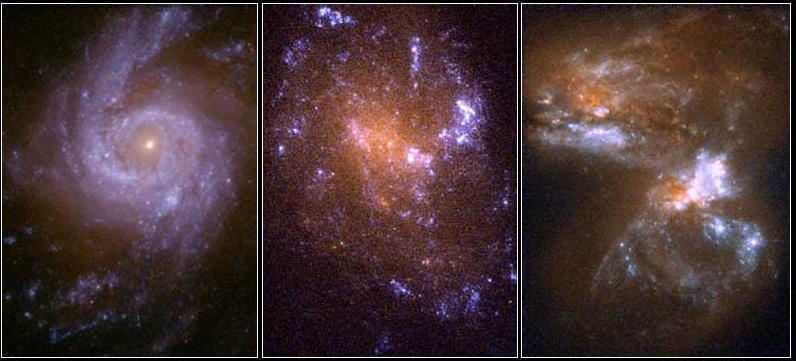Stellar Components
Galaxy magnitudes range from roughly -22 magnitudes (10
 L
L ) for giant ellipticals
down to -9 magnitudes (10
) for giant ellipticals
down to -9 magnitudes (10 L
L ) for dwarf ellipticals,
and vary with type. Spirals and lenticulars range from -22 to -16, and
irregulars from -18 to -12. The smallest galaxies, dwarf ellipticals, appear
to be no larger than globular clusters and have similar absolute magnitudes.
) for dwarf ellipticals,
and vary with type. Spirals and lenticulars range from -22 to -16, and
irregulars from -18 to -12. The smallest galaxies, dwarf ellipticals, appear
to be no larger than globular clusters and have similar absolute magnitudes.
The E, S0, and S types can be clearly distinguished in terms of luminosity
distributions. Ellipticals appear to be single-component, spheroidal systems
with red colours, often fit with r surface brightness
profiles. Ellipticals have nearly constant color distributions (B - V ~ 0.7),
suggesting that the same stellar types (G) dominate the luminosity throughout
these systems.
surface brightness
profiles. Ellipticals have nearly constant color distributions (B - V ~ 0.7),
suggesting that the same stellar types (G) dominate the luminosity throughout
these systems.
Lenticulars and spirals contain a central spheroidal distribution dominated
by K stars and similar to that of ellipticals, and a separate, independent
bluer (B - V ~ 0.5) exponential disk component, where the disk scale length
ranges from 1 to 5 kiloparsecs. The nuclear regions are bluer than the disks,
and there is a steady decrease in B - V colours from early (Sa) types towards
late (Sc, Sd) types. There is a radial trend across the disks towards bluer
light at large radii (indicative of young stars), particularly strong in the
late type spirals, and spiral arms are dominated by F, A and B stars (versus F
and G stars for the entire disk). We thus see evidence for types A through G
in most spirals, a far wider range of stellar types than is found in
elliptical systems.
How does dust affect these measurements?
How does inclination angle affect these measurements?
Do the images of stellar components reflect the mass of the galaxy, or
the luminosity?
How sensitive is the apparent morphology of a gaalxy to the imaging bandpass?
 |
|
Ultraviolet images of nearby galaxies NGC 3310, ESO 0418-008, and UGC 0647-2.
[NASA/HST, R. Windhorst] |
 |
|
Ultraviolet images of nearby galaxy NGC 6782.
[NASA/STScI/AURA] |

 L
L ) for giant ellipticals
down to -9 magnitudes (10
) for giant ellipticals
down to -9 magnitudes (10 L
L ) for dwarf ellipticals,
and vary with type. Spirals and lenticulars range from -22 to -16, and
irregulars from -18 to -12. The smallest galaxies, dwarf ellipticals, appear
to be no larger than globular clusters and have similar absolute magnitudes.
) for dwarf ellipticals,
and vary with type. Spirals and lenticulars range from -22 to -16, and
irregulars from -18 to -12. The smallest galaxies, dwarf ellipticals, appear
to be no larger than globular clusters and have similar absolute magnitudes.
 surface brightness
profiles. Ellipticals have nearly constant color distributions (B - V ~ 0.7),
suggesting that the same stellar types (G) dominate the luminosity throughout
these systems.
surface brightness
profiles. Ellipticals have nearly constant color distributions (B - V ~ 0.7),
suggesting that the same stellar types (G) dominate the luminosity throughout
these systems.

